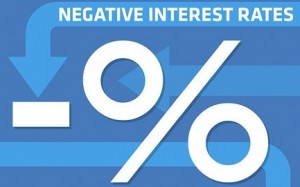Nouriel Roubini writes: Monetary policy has become increasingly unconventional in the last six years, with central banks implementing zero-interest-rate policies, quantitative easing, credit easing, forward guidance, and unlimited exchange-rate intervention. But now we have come to the most unconventional policy tool of them all: negative nominal interest rates.
Such rates currently prevail in the eurozone, Switzerland, Denmark, and Sweden. And it is not just short-term policy rates that are now negative in nominal terms: about $3 trillion of assets in Europe and Japan, at maturities as long as ten years (in the case of Swiss government bonds), now have negative interest rates.
Investors have long accepted real (inflation-adjusted) negative returns. When you hold a checking or current account in your bank at a zero interest rate – as most people do in advanced economies – the real return is negative (the nominal zero return minus inflation): a year from now, your cash balances buy you less goods than they do today.
In other words, negative nominal rates merely make your return more negative than it already was. Investors accept negative returns for the convenience of holding cash balances.
Moreover, if deflation were to become entrenched in the eurozone and other parts of the world, a negative nominal return could be associated with a positive real return. That has been the story for the last 20 years in Japan, owing to persistent deflation and near-zero interest rates on many assets.
One still might think that it makes sense to hold cash directly, rather than holding an asset with a negative return. But holding cash can be risky, as Greek savers, worried about the safety of their bank deposits, learned after stuffing it into their mattresses and walls: the number of armed home robberies rose sharply, and some cash was devoured by rodents. So, if you include the costs of holding cash safely – and include the benefits of check writing – it makes sense to accept a negative return.
Beyond retail savers, banks that are holding cash in excess of required reserves have no choice but to accept the negative interest rates that central banks impose; indeed, they could not hold, manage, and transfer those excess reserves if they were held as cash, rather than in a negative-yielding account with the central bank. Of course, this is true only so long as the nominal interest rate is not too negative; otherwise, switching to cash – despite the storage and safety costs – starts to make more sense.
In a “risk-off” environment, when investors are risk-averse or when equities and other risky assets are subject to market and/or credit uncertainty, it may be better to hold negative-yielding bonds than riskier and more volatile assets.
Over time, of course, negative nominal and real returns may lead savers to save less and spend more. And that is precisely the goal of negative interest rates: In a world where supply outstrips demand and too much saving chases too few productive investments, the equilibrium interest rate is low, if not negative. Indeed, if the advanced economies were to suffer from secular stagnation, a world with negative interest rates on both short- and long-term bonds could become the new normal.
To avoid that, central banks and fiscal authorities need to pursue policies to jump-start growth and induce positive inflation. Paradoxically, that implies a period of negative interest rates to induce savers to save less and spend more. But it also requires fiscal stimulus, especially public investment in productive infrastructure projects, which yield higher returns than the bonds used to finance them. The longer such policies are postponed, the longer we may inhabit the inverted world of negative nominal interest rates.

